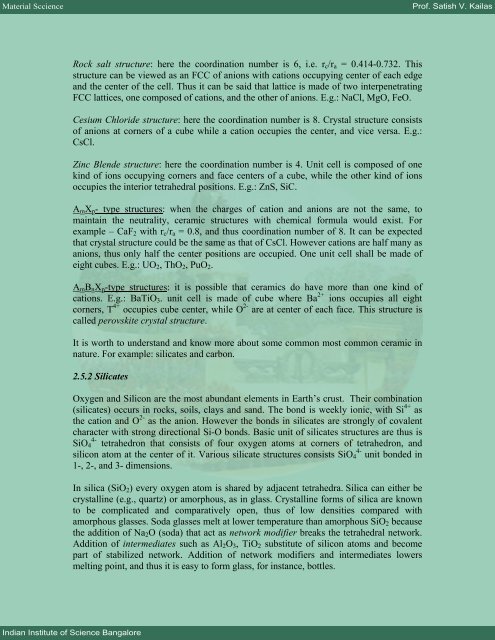Material Science - E-Courses
Material Science - E-Courses
Material Science - E-Courses
You also want an ePaper? Increase the reach of your titles
YUMPU automatically turns print PDFs into web optimized ePapers that Google loves.
<strong>Material</strong> Sccience Prof. Satish V. Kailas<br />
Rock salt structure: here the coordination number is 6, i.e. rc/ra = 0.414-0.732. This<br />
structure can be viewed as an FCC of anions with cations occupying center of each edge<br />
and the center of the cell. Thus it can be said that lattice is made of two interpenetrating<br />
FCC lattices, one composed of cations, and the other of anions. E.g.: NaCl, MgO, FeO.<br />
Cesium Chloride structure: here the coordination number is 8. Crystal structure consists<br />
of anions at corners of a cube while a cation occupies the center, and vice versa. E.g.:<br />
CsCl.<br />
Zinc Blende structure: here the coordination number is 4. Unit cell is composed of one<br />
kind of ions occupying corners and face centers of a cube, while the other kind of ions<br />
occupies the interior tetrahedral positions. E.g.: ZnS, SiC.<br />
AmXp- type structures: when the charges of cation and anions are not the same, to<br />
maintain the neutrality, ceramic structures with chemical formula would exist. For<br />
example – CaF2 with rc/ra = 0.8, and thus coordination number of 8. It can be expected<br />
that crystal structure could be the same as that of CsCl. However cations are half many as<br />
anions, thus only half the center positions are occupied. One unit cell shall be made of<br />
eight cubes. E.g.: UO2, ThO2, PuO2.<br />
AmBnXp-type structures: it is possible that ceramics do have more than one kind of<br />
cations. E.g.: BaTiO3. unit cell is made of cube where Ba 2+ ions occupies all eight<br />
corners, T 4+ occupies cube center, while O 2- are at center of each face. This structure is<br />
called perovskite crystal structure.<br />
It is worth to understand and know more about some common most common ceramic in<br />
nature. For example: silicates and carbon.<br />
2.5.2 Silicates<br />
Oxygen and Silicon are the most abundant elements in Earth’s crust. Their combination<br />
(silicates) occurs in rocks, soils, clays and sand. The bond is weekly ionic, with Si 4+ as<br />
the cation and O 2- as the anion. However the bonds in silicates are strongly of covalent<br />
character with strong directional Si-O bonds. Basic unit of silicates structures are thus is<br />
SiO4 4- tetrahedron that consists of four oxygen atoms at corners of tetrahedron, and<br />
silicon atom at the center of it. Various silicate structures consists SiO4 4- unit bonded in<br />
1-, 2-, and 3- dimensions.<br />
In silica (SiO2) every oxygen atom is shared by adjacent tetrahedra. Silica can either be<br />
crystalline (e.g., quartz) or amorphous, as in glass. Crystalline forms of silica are known<br />
to be complicated and comparatively open, thus of low densities compared with<br />
amorphous glasses. Soda glasses melt at lower temperature than amorphous SiO2 because<br />
the addition of Na2O (soda) that act as network modifier breaks the tetrahedral network.<br />
Addition of intermediates such as Al2O3, TiO2 substitute of silicon atoms and become<br />
part of stabilized network. Addition of network modifiers and intermediates lowers<br />
melting point, and thus it is easy to form glass, for instance, bottles.<br />
Indian Institute of <strong>Science</strong> Bangalore

















